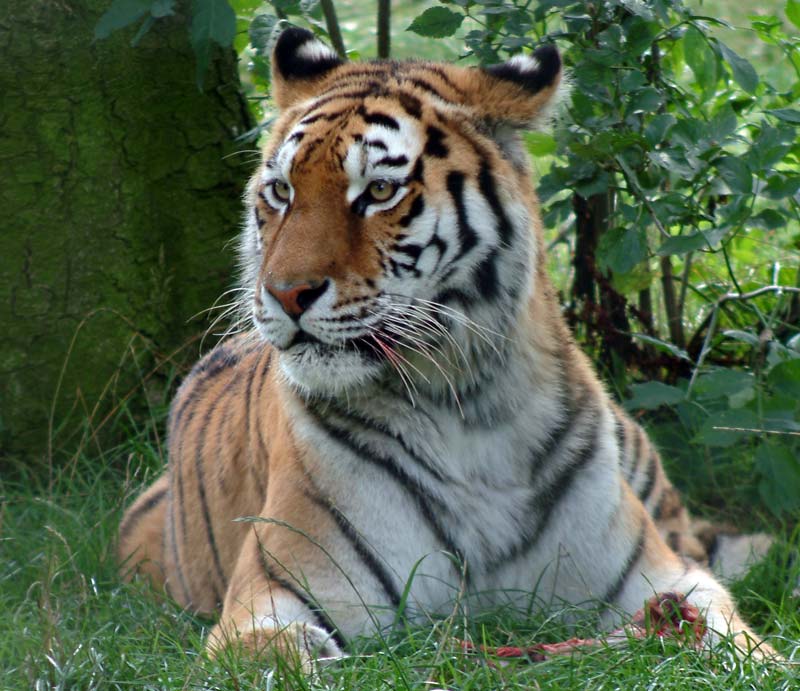Siberian Tiger facts
Posted in Wildlife A-Z | January 25, 2011 | Comment NowAlso known as Amur, a Siberian tiger refers to the giant carnivores that mostly tend to survive in the coldest regions of our planet. It is certainly the largest cat in the world, but is sadly today among the endangered animals. Currently, these superb tigers are seen typically in southeastern Russia, especially in Siberia; which says much about their origins. Although they were seen in plenty in Korea, Mongolia, as well as China; illegal poaching has reduced their numbers here. Across the world, it is now accepted that some 350 to 400 tigers only survive in the forests and other 500 in the zoos. In order to save them, efforts have been made due to which now they are heavily safeguarded in wild, but a majority of them are now in zoos. These were some vital Siberian Tiger facts regarding their current situation. Now, I will disclose a few interesting facts of these mammoth tigers!
- Physical features: Siberian tigers are muscular creatures of around 850 pounds in weight and 10 to 12 feet in height. The color of their skin is pale orange coated with stripes in not pure black, but dark brown. However, there are also Siberian tigers in white coat with chocolate stripes. As per the type of tooth, their size changes anywhere between 1 and 3 inches, but the canines are the longest. Whiskers of 15 cm around are sensitive, longer in males, and are utilized for sensory perception. There is no specific mating season for them and they attain maturity between 3 to 5 years. Surprisingly, these tigers can jump until 23 feet and can also survive heavy iciness.
- Cubs: One of the interesting Siberian Tiger facts is that the cubs are blind when they are born. So, the mothers protect them heavily for some 8 weeks after which these small ones slowly wander around with their mothers. At 1, they aid in hunting, while at 3 marking full maturity in most, they start hunting independently.
- Diet: These wild cats require daily 20 pounds of meat and mostly prey on elk, deer, and pigs (wild ones). It is only on days of lack of food that they attack fish, frogs, fowls, and monkeys. One of the most surprising Siberian Tiger facts is that only 1 of every 10 hunting jumps give them results. The chronicles reveal that a tiger in search of food can run over 600 miles, eat daily 200 pounds of meat, and can also eat 100 pounds in one go. As compared to the Bengal tigers, these are rare man-eaters. As of the records, only six events of eating men have been noticed in the 20th century. Bears are one of their favorites, especially the brown bears as they cannot climb the trees.
- Hunting: Siberian tigers acquire the ‘ambush’ while hunting method in which they tend to attack from a distance of 30 to 80 feet from their prey. If there is a fight, these tigers caution the trespasser by rattling their tail well in advance.
- Though the male tiger fights for its territory fiercely, it won’t harm an intruder female with cubs.
- Habitat: Male Siberian tigers love a private life as well as big personal territories of which many go beyond 4000 square miles. Unlike the males, the females take care of cubs and stay with their own families. A majority of them are mostly nocturnal. Formerly found in plenty in Korea, China, Mongolia, and Russia; today they are only seen in eastern Russia. These tigers are usually killed for utilizing their costly skins and also for preparing a few medicines (China).
- Life span: This is up to 25 years. However, those living in the wild tend to live longer as compared to those in captivity.
- Identity: The locals of Siberia identify these tigers as the animals of great respect. In fact, the Tungusic folks call them ‘Old Man’ or ‘Grandfather’, whereas the people of Nanai refer to them as ‘Amba’. Now, this is one of the most surprising Siberian Tiger facts.





 Save to delicious
Save to delicious Stumble it
Stumble it